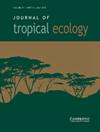气候变化下埃塞俄比亚森林香料胡椒和阿夫拉蒙的潜在适宜生境预测
IF 1
4区 环境科学与生态学
Q4 ECOLOGY
引用次数: 2
摘要
持续的气候变化可能导致植物物种适应范围的变化。但对于热带地区的许多物种来说,人们对这种影响知之甚少。本文研究了两种原生林香料胡椒(Piper capense)和阿夫拉蒙(Aframomum corrorima)目前和未来潜在适宜生境的分布。我们使用了MaxEnt软件来预测这些物种当前和未来的适宜栖息地。采用了2050年和2070年的两种未来气候变化情景,即中等(代表性浓度路径[RCP 4.5])和极端(RCP 8.5)情景。结果表明,黄花紫杉和芫花紫杉的发生资料分别为60份和74份,环境变量为22个。利用线性模型研究了海拔高度、太阳辐射指数(SRI)和地形位置指数(TPI)对这两种树种适宜生境的影响。最干旱季降水、SRI和TPI对capense和A. corrorima未来适宜生境有显著影响。此外,在未来情景下,两种物种的适宜栖息地都有显著的海拔变化(P < 0.001)。这些新的适宜栖息地位于湿润的非洲山地和Combretum-Terminalia植被中。我们的研究结果表明,这些物种的保护规划应考虑气候变化因素,包括辅助迁移。本文章由计算机程序翻译,如有差异,请以英文原文为准。
Predicting the potential suitable habitats of forest spices Piper capense and Aframomum corrorima under climate change in Ethiopia
Continuing climate change may cause shifts in the adaptive ranges of plant species. But this impact is less understood for many species in the tropics. Here, we examined the distribution of the current and future potential suitable habitats of two native forest spices Piper capense and Aframomum corrorima. We have used MaxEnt software to predict the current and future suitable habitats of these species. Two future climate change scenarios, that is, middle (Representative Concentration Pathway [RCP 4.5]) and extreme (RCP 8.5) scenarios for years 2050 and 2070, were used. A total of 60 and 74 occurrence data of P. capense and A. corrorima, respectively, and 22 environmental variables were included. The effects of elevation, solar radiation index (SRI) and topographic position index (TPI) on suitable habitats of these species were tested using linear model in R. Precipitation of the driest quarter, SRI and TPI significantly affect future suitable habitats of P. capense and A. corrorima. Furthermore, there are significant elevational shifts of suitable habitats for both species under future scenarios (P < 0.001). These novel suitable habitats are located in moist Afromontane and Combretum-Terminalia vegetations. Our results suggest that conservation planning for these species should consider climate change factors including assisted migration.
求助全文
通过发布文献求助,成功后即可免费获取论文全文。
去求助
来源期刊

Journal of Tropical Ecology
环境科学-生态学
CiteScore
2.10
自引率
0.00%
发文量
44
审稿时长
18-36 weeks
期刊介绍:
Journal of Tropical Ecology aims to address topics of general relevance and significance to tropical ecology. This includes sub-disciplines of ecology, such as conservation biology, evolutionary ecology, marine ecology, microbial ecology, molecular ecology, quantitative ecology, etc. Studies in the field of tropical medicine, specifically where it involves ecological surroundings (e.g., zoonotic or vector-borne disease ecology), are also suitable. We also welcome methods papers, provided that the techniques are well-described and are of broad general utility.
Please keep in mind that studies focused on specific geographic regions or on particular taxa will be better suited to more specialist journals. In order to help the editors make their decision, in your cover letter please address the specific hypothesis your study addresses, and how the results will interest the broad field of tropical ecology. While we will consider purely descriptive studies of outstanding general interest, the case for them should be made in the cover letter.
 求助内容:
求助内容: 应助结果提醒方式:
应助结果提醒方式:


